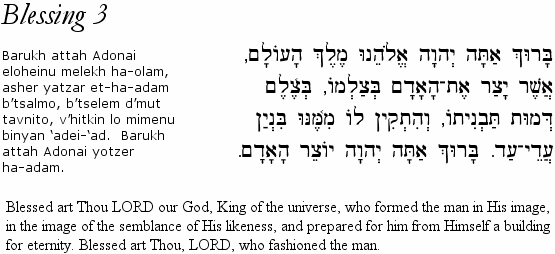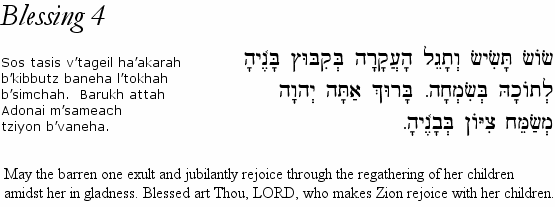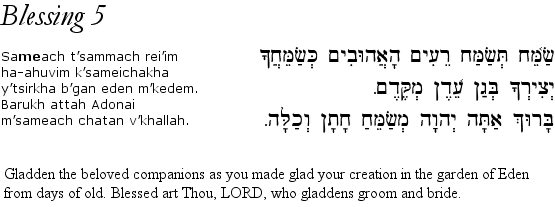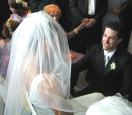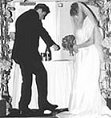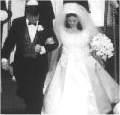|
|
 |
 |
|
Jewish Wedding Blessings -
|
|
|
|
|
 |
 |
|
I am my beloved's, and my beloved is mine: he feedeth among the lilies.
- Song of Solomon 6:3
|
 |
 |
|
According to a well-known midrash, after God created the universe in six days, He has been arranging marriages ever since; and according to the Talmud, 40 days before a male child is conceived a voice from heaven announces whose daughter he is to marry (in Yiddish, such a "heavenly match" is called "bashert," a word meaning "destiny"). The steps leading up to a marriage proposal are sometimes called a shidduch and, in former days, were arranged by the shadkhan, or matchmaker.
|
|
|
 |
 |
|
The Betrothal - אֵרוּסִין
The process of getting married occurs in two stages: erusim (betrothal) and nisuin (marriage ceremony). Erusin is a religious ceremony in its own right, more binding than an engagement, and once it occurs the woman is considered legally the wife of the man. As part of the erusim, the husband gives the wife a ketubah (marriage contract) that is later signed and displayed in the couple's home. However, since the spouses do not live together at this time, the mutual obligations of the ketubah do not take effect until the actual marriage ceremony (nisuin) is complete. Today it is common for both the erusim and nusuin ceremonies to be performed together during the wedding.
|
 |
 |
|
The Week before the Marriage
It is customary for the kallah (bride) and chatan (groom) not to see each other for a week preceding the wedding day. Separate receptions, called Kabbalat Panim, are held just prior to the wedding ceremony.
|
|
|
 |
 |
|
The couple is compared to to a queen and a king. The kallah is seated on a "throne" to receive her guests, while the chatan is surrounded by guests who sing and toast him. There is also a tradition for the mother of the bride and the mother of the groom to stand together and break a plate. The reason is to show the seriousness of the commitment -- just as a plate can never be fully repaired, so too a broken relationship can never be fully repaired.
|
|
 |
 |
|
The Wedding Day
The wedding day itself is thought of as a personal Yom Kippur for the bride and groom. Accordingly, both will fast (from dawn until after the completion of the marriage ceremony), and at the ceremony the groom will wear a kittel, the traditional white robe worn on Yom Kippur.
|
 |
 |
|
The Custom of Bedeken
Before the wedding ceremony occurs, the chatan, accompanied by family and friends, proceeds to the kallah's room and places the veil over her face. This is an ancient custom and perhaps is meant to reassure the groom that his bride is the one who is beneath the veil!
|
|
|
 |
 |
|
Coming under the Chupah
The wedding ceremony takes place under the chupah, a canopy held up by four poles, symbolic of their dwelling together and of the husband's bringing the bride into his home. The chupah may be erected outside, as a sign of the blessing given by God to the patriarch Abraham that his children shall be "as the stars of the heavens." The cantor usually calls out for the groom with the "Barukh haba" invocation and then for the bride with the "B'rukha haba'ah" invocation.
The chatan, followed by the kallah, are usually escorted to the chupah by their respective sets of parents. Under the chupah, the kallah circles the chatan seven times (there are various explanations for this custom, such as that the number seven indicates completion or wholeness). The kallah then settles at her chatan's right-hand side.
|
 |
 |
|
The Kiddushin Ceremony - קִדּוּשִׁין
Kiddushin makes formal and sanctifies the erusim ceremony. Kiddushin is the sanctification of a man and woman to each other, and a cup of wine is used for a special kiddush betrothal blessing from which the couple drinks.
|
|
|
 |
 |
|
The chatan now takes the wedding ring in his hand (often inscripted with dodi li v'ani lo - see below), and in clear view of two witnesses ('edim), declares to his wife, "Behold, you are betrothed unto me with this ring according to the laws of Moses and Israel."
|
|
 |
 |
|
He then places the ring on the forefinger of his bride's right hand. According to Jewish law, this is the central moment of the wedding ceremony, and the couple is now fully married at this point. Once the ring is placed on the bride's finger, the ketubah (marriage contract) is read aloud and handed to the groom, who then presents it to his bride.
The Nisuin Ceremony - נִשׂוּאִין
A second cup of wine is poured out and the seven blessings (sheva berachot) are recited. The blessings may be recited by several different people selected by the groom and bride.
|
 |
 |
|
The Smashed Glass
After the seven blessings are recited, the couple drinks from the cup and the groom will smash a glass with his right foot (to symbolize that even the most blessed moment is tempered with sorrow as long as the Temple in Jerusalem has not been rebuilt). It is customary for the witnesses to shout "Mazal Tov!" at this point in the ceremony.
|
|
|
|
|
 |
 |
|
Yichud
The couple then retires briefly to a completely private room, symbolic of the groom bringing the wife into his home. Here they are alone together for the first time, and may eat a small snack to break their fast.
|
|
 |
 |
|
The Seudah
Most Jewish celebrations are followed by a dinner to honor the occasion. At this meal all guests participate in the Mitzvah of L'Sameach Chatan v'Kallah, to celebrate in joy with the groom and bride.
At the end of the Seudat Mitzvah (festive meal), "Birkat HaMazon" (Grace After Meals) is recited, and the Sheva Berachot (seven blessings) recited under the Chupah are once again repeated.
The first Seven Days of Marriage
In the tradition that harkens back to the seven-day celebration after the marriage of Jacob to Leah (Genesis 29), for seven consecutive evenings following the wedding friends or relatives will provide festive meals in honor of the newlyweds (this is perhaps a picture of the rapture of the church -- that is, the seven year period in which believers in the Mashiach Yeshua will celebrate with Him while the great tribulation occurs on the earth).
|
|





